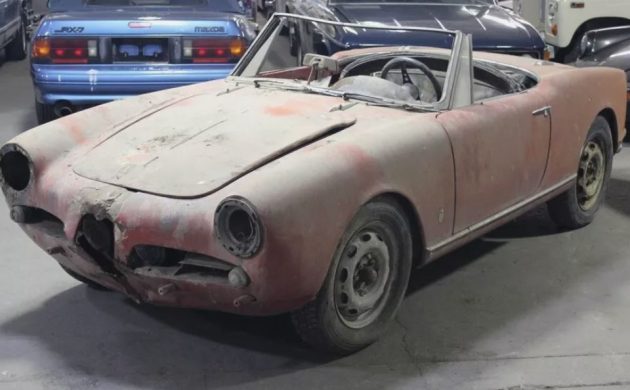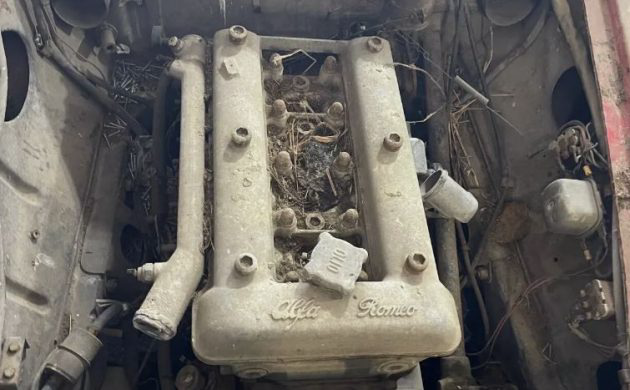Alfa Romeo was famous for making specialty versions of its production cars. These were not always responsive to performance demands in the market – sometimes folks just wanted a roomy berlina to haul the family. But in the spider market, the most robust demarcation of value stands between the “normale” and the peppier “veloce” versions of each model. Higher values for the veloce have spawned a series of altered cars, sometimes with nefarious intent. Also important is whether the car is a Giulietta or a Giulia, and this car sits on the dividing line – 1962 – for the changeover. The early cars were powered by a 1290 cc twin-cam; the motor grew to 1570 ccs in the Giulietta. However, the veloce version of the Giulietta was not introduced until 1964. Later Giulias have a five-speed transmission – a desirable feature. We think our subject car – listed here on eBay with a $14,950 buy-it-now price – is indeed a veloce, supporting a high price versus condition. One clue is the horizontal air splitter inside the driver’s side grille – not found on a “normale”. The instruments should be marked with higher ranges, and the fuel pump is electric. But writing to Alfa is a worthwhile undertaking; the document center can tell you about your car and confirm its specifications more accurately than the Fusi production data from “Tutte le Vetture dal 1910”.
Unfortunately, the engine bay components may not be recoverable since the car has sat for thirty years in an open barn. There’s no such thing as “matching numbers” in the vintage Alfa world – the best you can do is determine that your motor came from a pile of motors made at about the correct time. If the block needs to be replaced, sourcing on from the same era is desirable. The 1290 cc twin-cam four-cylinder should breathe through two twin-choke Webers and make about 96 hp. This Giulietta would have a four-speed gearbox; once the car is brought to running condition, you can expect a balky second-gear synchro – seems to be an Alfa hallmark.
The interior has seen some modifications that make me believe it may have seen track time. Three extra gauges, set in ferrules that tilt to the driver are installed in the center of the dash, and the lower panel that holds the switches is missing. That beefy steering wheel doesn’t resemble the delicate counterpart from 1962, and the gear shift has been changed out. The top bows remain with the car. Residing under those floors is rust, the bane of Alfa restorers everywhere. If this one finds a brave new owner, he’ll collect the car from Elyria, Ohio.
The Giulietta spider was penned by Pininfarina. Once gussied up with bright paint and trim, the slightly plain-vanilla styling becomes more appealing. Other than the rust below, this one’s topside suffers from dents, misalignment, a broken trunk hinge, and simply missing items. So why the high price for such a derelict example? Despite softening prices in nearly every corner of the market, early veloce-spec Alfas can still sell for six figures. That said, restoration will be a labor of love, completely unhinged from the financial reward.






These guys deal in junk.
Believe it or not, this isn’t the worst Alfa spider I’ve seen for “restoration”! Some are abominable.
Interesting. The floors have rust but the frame rails to my eye seem solid, and sheet metal topside seems fine. It’s not worth it to me but to someone else for a six figure payoff… It comes down to if you can’t or won’t drive it when it’s finished what’s the point?
Beautiful car mistreated.
I’ve seen ” restored” Spiders that flexed on the car lift. So better to start from here than there.
Parts are easily available, check if or if not a Veloce. If not, that doesn’t need to be a deal- breaker, depending on buyer’s objective.
The serial number stamped in the firewall just above the passenger fresh air hose should have an F stamped in, most F stamps are not aligned well with the
Serial numbers. Where are the Webers and Veloce air filter canister? Pricey items
these’n similar are what ‘I cut my eye teeth on’ wrenchin. And…
in better shape back in the day ( late 60s thru early ‘80s). “Goldie’s”
yard was full of 50s/60s Italian jems, even hard tops and 4 doors.
Back every 9 mo to 18 mo for another (knew the place pretty well, what
came in when, where to get prts for ones I’d pulled out nearly whole).
A boy’s delight
This listing was ended by the seller on Sun, Nov 17 at 8:12 AM because there was an error in the listing.
Relisted here
https://www.ebay.com/itm/326342302270
Lower price $12,950